Students address food waste, water shortages, food safety at White House Science Fair
June 06, 2014 | 03:03 PM
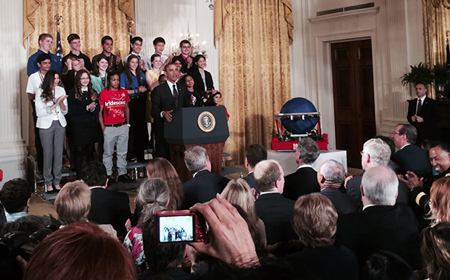 President Obama addresses those attending the annual White House Science Fair last week. (Jerry Hagstrom/The Hagstrom Report)
President Obama addresses those attending the annual White House Science Fair last week. (Jerry Hagstrom/The Hagstrom Report)Agriculture Secretary Tom Vilsack has launched a campaign to reduce food waste in landfills, but he won’t have to look any farther for new ideas on how to accomplish that or for ideas on conservation and food safety than some of the exhibitors at this year’s White House Science Fair.
Students chosen to display their work included a group of Delaware middle school students with a plan to reduce food waste in landfills, a Minnesota student working on reducing water needed for growing turfgrass and a Connecticut student who uses earthworms to prevent the spread of palnt-borne E coli.
And at least two students also got to wear their FFA jackets to the White House.
The fair, held May 27, gave more than 100 students from more than 30 states who have won science, technology, engineering and math (STEM) competitions around the country the chance to exhibit their work before President Barack Obama and an audience of science educators and business leaders.
After touring the exhibits, Obama noted, “This is one of my favorite things all year long.”
The president noted that he had hosted the Super Bowl champion Seattle Seahawks the week before.
“But what’s happening here is more important,” he said. “As a society, we have to celebrate outstanding work by young people in science at least as much as we do Super Bowl winners.”
And this year, he noted, the White House was placing special emphasis on recognizing “all the amazing girls and young women who are excelling at science and technology and engineering and math.”
While the exhibits reflected the broad range of science, several focused on agricultural projects.
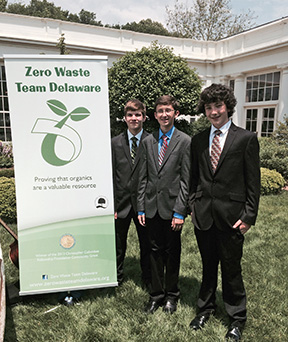
Reducing waste in landfills
Three middle school students from Hockessin, Del. — Aaron Knestaut, 13, Eric Long, 14, and Max Huhn, 13 — formed a “Zero Waste” team who revealed that more than half of the waste placed in Delaware’s landfills can actually be composted.
By collecting organic compost at curbside and diverting organic waste away from the landfills, the team expects to extend the life expectancy of the state’s landfills and reduce the negative effects on the environment. The Zero Waste Team was awarded the $25,000 Columbus Foundation Community Grant for their innovative project.
In an interview, Long said he got interested in composting when he read how big a problem food waste is in landfills and concluded that because food waste is organic material it could be recycled rather than sent to landfills.
The team has launched a website where people can learn how to teach their haulers to recycle yard waste, and include food scraps, food soiled paper products, natural fibers, and plant trimmings.
“Delaware’s organic waste could make biofuels with a market of $112 million to $200 million or could also produce 50 meagawatts of power, enough for 50,000 homes,” the team noted in a project synopsis.
▪ Zero Waste Team Delaware
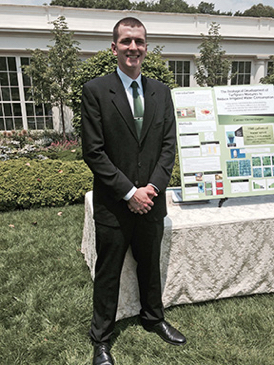
Reducing turfgrass water use
Connor Klemenhagen, 19, a Champlin, Minn., resident who is now a student at the University of Minnesota, was inspired to explore the science of turfgrass after a seventh-grade field trip to an ecosystem-reserve.
He also worked on a farm in 2011 moving irrigation lines and observed how much water farms need. He then learned that if football fields, golf courses and residential lawns are added up, turfgrass would be considered the largest irrigated crop in the United States — occupying more land area than corn, wheat, and soybeans combined.
Klemenhagen noted in a paper distributed at the White House that Americans use 30 to 60 percent of their residential water for lawn irrigation and that “This unsustainable consumption of precious resources on a massive scale provides substantial and essential reason to reduce the amount of water used by our lawns.”
In an interview, Klemenhagen said he compared turfgrass to prairie grass, which is sustainable without irrigation, and researched what grasses might be mixed together to reduce the need for water but maintain the appearance that is expected.
He concluded that a mixture of hard or tall fescue plus Kentucky bluegrass would use 8.2 percent less water and maintain the visual aesthetic of a desirable lawn.
In a brief but severe drought, a one-acre lawn with this mixture would use 3,500 fewer gallons of water than a conventional lawn, he said.
Klemenhagen’s research won the 2013 National Junior Science and Humanities Symposium, a competition sponsored by the Army, Navy, and Air Force. He is a cadet in the Army ROTC program.
▪ Junior Science and Humanities Symposium
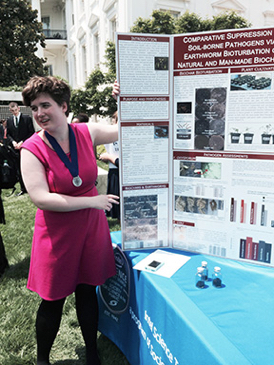
Suppressing soil-borne diseases
Anne Merrill, 17, of Old Greenwich, Conn., studied natural, non-chemical methods for suppressing soil-borne diseases.
She looked at how “biochars,” a charcoal-like material created by burning organic waste to sequester carbon, can be integrated into topsoil by earthworms as they burrow and digest soil.
Her results suggest that combining the natural methods of earthworm bioturbation with biochars in soil may help reduce carbon emissions, prevent the spread of plant-borne E. coli, and increase agricultural yields.
Merrill is president of her high school’s art club, has exhibited her nature-inspired art in several shows, and placed first in Princeton University’s Playwriting Competition.
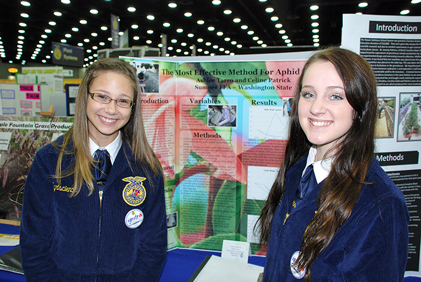 Two winners in the 2013 National FFA Agriscience Fair were invited to the 2014 White House Science Fair, which focused on girls who have excelled in science and math. Ashlee Tarro, left, and Celine Patrick, both of Sumner High School in Sumner, Wash., explored methods to control aphids on plants in the school greenhouse. (National FFA)
Two winners in the 2013 National FFA Agriscience Fair were invited to the 2014 White House Science Fair, which focused on girls who have excelled in science and math. Ashlee Tarro, left, and Celine Patrick, both of Sumner High School in Sumner, Wash., explored methods to control aphids on plants in the school greenhouse. (National FFA)Controlling aphids
The fair also provided an opportunity for two students from Sumner, Wash., north of Seattle to wear their FFA jackets at the White House.
Celine Patrick and Ashlee Tarro won first place in the plant division at the 2013 National FFA Agriscience Fair for their research on how to control aphids.
While Tarro stood on the stage with Obama, Patrick told The Hagstrom Report the story of their project.
“In our school’s greenhouse, we were having a serious infestation of aphids — or plant lice,” Patrick said. “We didn’t want to have to resort to the use of harsh pesticides to try and eliminate the infestation.”
The solution turned out to be confining ladybugs in the greenhouse so that the aphids were their only source of food, Patrick said.
▪ National FFA Agriscience Fair
▪ White House Science Fair Background
▪ White House — Meet the Exhibitors in 2014 White House Science Fair